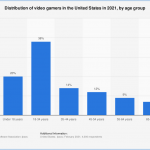Gone are the days when the stereotypical image of a gamer was a teenage boy locked in his bedroom. PC gaming has expanded far beyond that narrow demographic, appealing to people across ages, genders and nationalities. As the community diversifies, so does the gaming experience offered to players.
Let’s explore some illuminating statistics about who exactly plays on the PC today and what captivates their interest.
Highlights
● PC gaming generated $12.67 billion in revenue in 2024 and is expected to grow 16.7% year-over-year.
● 83% of PC game purchases were digital downloads versus physical copies in 2022.
● Laptops have become a top choice for PC gaming, used by 38% of dedicated players.
● Weekly time spent playing averaged 7.6 hours globally, with US gamers logging the most at over 1 hour daily.
● In 2024, Asia accounted for 700 million out of 1.83 billion PC gamers worldwide.
Market Growth Drivers
The PC gaming landscape has expanded drastically from the early days of basic 2D games. With more advanced graphics, in-game purchases, multiplayer worlds and esports competitions, PC gaming is projected to become a $22.7 billion market by 2027.
Another key driver is digital distribution, which offers greater accessibility and discounts for players. Major platforms like Steam have amassed over 120 monthly active users. Cloud gaming services are also removing hardware barriers so gaming can happen instantly across devices.
The popularity of live streaming has forged engaged gaming communities on sites like Twitch and YouTube. Top streamers relay new game releases, host tournaments, share tips and foster memes around beloved titles.

Regional Differences
Asia leads the global landscape with 700 million PC gamers. Countries like China and Korea have established competitive esports scenes and solid internet infrastructure for online multiplayer matches.
In the U.S, forecasts predict the gamer population will rise from 214 million in 2024 to 240 million by 2027. Compared to single-player titles, online games thrive in the western market where friendship-driven team play is popular.
Europe strikes a balance with strong solo play participation across RPG and strategy genres as well as active esports. Germany spends slightly less daily time playing (40 minutes) but monetizes well through in-game transactions.
Who’s Playing?
Once a male teen playground, gaming now spans ages and genders more equally. Thirty-one percent of U.S. players fall between 30-39 years old while 60-64 year-olds make up a significant 8%.
As for gender, 2024 marked the closing gap with a 46% female player base in America anticipated to soon eclipse the 53% male majority. Top female streamers like Pokimane proudly lead the charge, raking in $7 million yearly from 9.4 million loyal followers.
While women play casual games more on mobile, they tie males in enjoying action-adventure and RPG genres on PC. Features like customization and quest-based stories now deliberately cater to diverse playstyles.
Titles That Topplay Lists
Approachability combined with depth helps certain PC games achieve long-lasting success. For example, Minecraft and Roblox each retain over 1 million monthly players through simplicity meeting creativity. Their block-building allows both newbies and experts to shape vast worlds limited only by imagination.
Competitive games like League of Legends further hook players by constantly updating rosters and strategies to master. The thrill of outmaneuvering human opponents poses an addictive challenge for the game’s 1.34 million dedicated monthly fanbase.

As technology and design enable more immersive experiences, the borders defining who can game and why will continue fading. In an industry projected to soon hit $22.7 billion, PC gaming has become a culture embracing all ages and backgrounds under the unifying joy found in play. The faces behind the screens are as multifaceted as the virtual worlds open for exploration.

